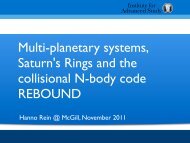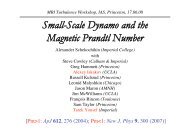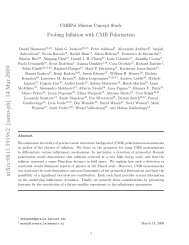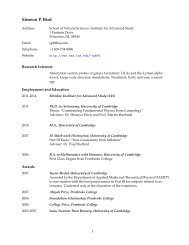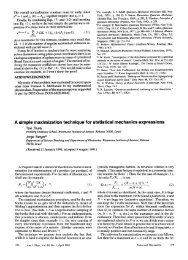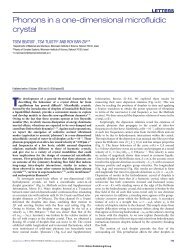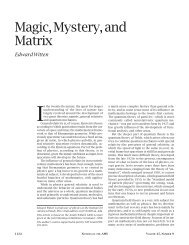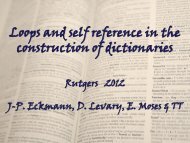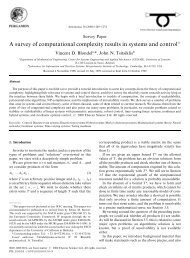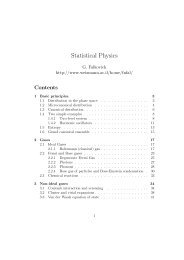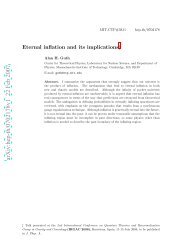Introduction to String Theory and D–Branes - School of Natural ...
Introduction to String Theory and D–Branes - School of Natural ...
Introduction to String Theory and D–Branes - School of Natural ...
Create successful ePaper yourself
Turn your PDF publications into a flip-book with our unique Google optimized e-Paper software.
where a, b, c, d are complex numbers, with for invertability, the determinant <strong>of</strong> the matrix<br />
<br />
a b<br />
c d<br />
should be non–zero, <strong>and</strong> after a scaling we can choose ad − bc = 1. This is the group SL(2, C) which is<br />
indeed isomorphic <strong>to</strong> SO(3, 1). In fact, since a, b, c, d is indistinguishable from −a, −b, −c, −d, the correct<br />
statement is that we have invariance under SL(2, C)/Z2.<br />
For the open string we have the upper half plane, <strong>and</strong> so we are restricted <strong>to</strong> considering maps which<br />
preserve (say) the real axis <strong>of</strong> the complex plane. The result is that a, b, c, d must be real numbers, <strong>and</strong> the<br />
resulting group <strong>of</strong> invertible transformations is SL(2, R)/Z2. Correspondingly, the infinite part <strong>of</strong> the algebra<br />
is also reduced in size by half, as the holomorphic <strong>and</strong> antiholomorphic parts are no longer independent.<br />
Notice that the dimension <strong>of</strong> the group SL(2, C) is six, equivalent <strong>to</strong> three complex parameters. Often,<br />
in computations involving a number <strong>of</strong> opera<strong>to</strong>rs located at points, zi, a conventional gauge fixing <strong>of</strong> this<br />
invariance is <strong>to</strong> set three <strong>of</strong> the points <strong>to</strong> three values: z1 = 0, z2 = 1, z3 = ∞. Similarly, the dimension <strong>of</strong><br />
SL(2, R) is three, <strong>and</strong> the convention used there is <strong>to</strong> set three (real) points on the boundary <strong>to</strong> z1 = 0, z2 =<br />
1, z3 = ∞.<br />
3.2.1 States <strong>and</strong> Opera<strong>to</strong>rs<br />
A very important class <strong>of</strong> fields in the theory are those which transform under the SO(2, D) conformal group<br />
as follows:<br />
φ(x µ ) −→ φ(x ′µ <br />
<br />
) = <br />
∂x<br />
∂x<br />
′<br />
∆<br />
D<br />
<br />
φ(x µ ) = Ω ∆<br />
2 φ(x µ ) . (135)<br />
Here, ∂x<br />
∂x ′<br />
<br />
is the Jacobian <strong>of</strong> the change <strong>of</strong> variables. (∆ is the dimension <strong>of</strong> the field, as mentioned earlier.)<br />
Such fields are called “quasi–primary”, <strong>and</strong> the correlation functions <strong>of</strong> some number <strong>of</strong> the fields will inherit<br />
such transformation properties:<br />
In two dimensions, the relation is<br />
<br />
<br />
= <br />
∂x<br />
∂x<br />
′<br />
<br />
<br />
<br />
<br />
∆ 1<br />
D<br />
x=x1<br />
φ(z, ¯z) −→ φ(z ′ , ¯z ′ ) =<br />
<br />
<br />
· · · <br />
∂x<br />
∂x<br />
′<br />
<br />
<br />
<br />
<br />
∆n<br />
D<br />
x=xn<br />
(136)<br />
<br />
∂z<br />
∂z ′<br />
h <br />
∂¯z<br />
∂¯z ′<br />
¯ h<br />
φ(z, ¯z) , (137)<br />
where ∆ = h + ¯ h, <strong>and</strong> we see the familiar holomorphic fac<strong>to</strong>rization. This mimics the transformation<br />
properties <strong>of</strong> the metric under z → z ′ (z):<br />
g ′ <br />
∂z<br />
z¯z =<br />
∂z ′<br />
<br />
∂¯z<br />
∂¯z ′<br />
<br />
gz¯z ,<br />
the conformal mappings <strong>of</strong> the plane. This is an infinite dimensional family, extending the expected six <strong>of</strong><br />
SO(2, 2), which is the subset which is globally well–defined. The transformations (137) define what is called<br />
a “primary field”, <strong>and</strong> the quasi–primaries defined earlier are those restricted <strong>to</strong> SO(2, 2). So a primary is<br />
au<strong>to</strong>matically a quasi–primary, but not vice–versa.<br />
In any dimension, we can use the definition (135) <strong>to</strong> construct a definition <strong>of</strong> a conformal field theory<br />
(CFT). First, we have a notion <strong>of</strong> a vacuum |0> which is SO(2, D) invariant, in which all the fields act. In<br />
such a theory, all <strong>of</strong> the fields can be divided in<strong>to</strong> two categories: A field is either quasi–primary, or it is a<br />
linear combination <strong>of</strong> quasi–primaries <strong>and</strong> their derivatives. Conformal invariance imposes remarkably strong<br />
constraints on how the two– <strong>and</strong> three–point functions <strong>of</strong> the quasiprimary fields must behave. Obviously,<br />
for fields placed at positions xi, translation invariance means that they can only depend on the differences<br />
xi − xj.<br />
34



